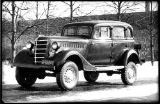
GAZ-61
Encyclopedia
GAZ-61 was a four wheel drive
car from USSR manufacturer GAZ
first introduced in 1938 by designer V. A. Gratchev, to replace his too-complex model GAZ-M21. Production did not start until 1940. It was made by putting the GAZ M2 body on a four-wheel-drive chassis (the world's first all-wheel drive passenger car). It could climb angles up to 38 degrees and cross water up to 72 cm (28.3 in) deep.
The first version, produced from 1940 to 1941, was a 5-seated 4-door phaeton
. It was powered by a 3485 cc 6-cyl 4-stroke engine with 85 hp and a top speed of 100 km/h (62 mph). Many supreme commanders of the Red Army
headquarters used this car in 1941.
In 1941, the updated GAZ-61-73 was introduced. It was now a 5-seat, 4-door 6-light saloon with the same engine, but now rated at a top speed of 107 km/h (66 mph).
The GAZ-61 was produced not only in civilian black but also in in blue and Russian 4BO green, together with the typical cross-country tread tires.
Four Wheel Drive
The Four Wheel Drive Auto Company, more often known as Four Wheel Drive or just FWD, was founded in 1909 in Clintonville, Wisconsin, as the Badger Four-Wheel Drive Auto Company by Otto Zachow and William Besserdich.-History:...
car from USSR manufacturer GAZ
GAZ
GAZ or Gorkovsky Avtomobilny Zavod , translated as Gorky Automobile Plant , started in 1932 as NAZ, a cooperation between Ford and the Soviet Union. It is one of the largest companies in the Russian automotive industry....
first introduced in 1938 by designer V. A. Gratchev, to replace his too-complex model GAZ-M21. Production did not start until 1940. It was made by putting the GAZ M2 body on a four-wheel-drive chassis (the world's first all-wheel drive passenger car). It could climb angles up to 38 degrees and cross water up to 72 cm (28.3 in) deep.
The first version, produced from 1940 to 1941, was a 5-seated 4-door phaeton
Phaeton body
A Phaeton is a style of open car or carriage without proper weather protection for passengers. Use of this name for automobiles was limited to North America or its products....
. It was powered by a 3485 cc 6-cyl 4-stroke engine with 85 hp and a top speed of 100 km/h (62 mph). Many supreme commanders of the Red Army
Red Army
The Workers' and Peasants' Red Army started out as the Soviet Union's revolutionary communist combat groups during the Russian Civil War of 1918-1922. It grew into the national army of the Soviet Union. By the 1930s the Red Army was among the largest armies in history.The "Red Army" name refers to...
headquarters used this car in 1941.
In 1941, the updated GAZ-61-73 was introduced. It was now a 5-seat, 4-door 6-light saloon with the same engine, but now rated at a top speed of 107 km/h (66 mph).
The GAZ-61 was produced not only in civilian black but also in in blue and Russian 4BO green, together with the typical cross-country tread tires.

